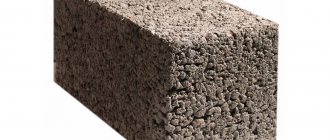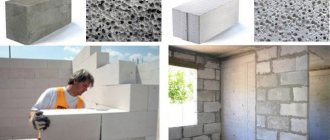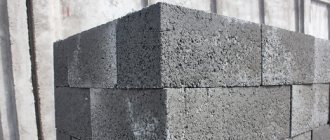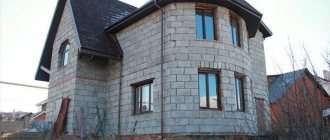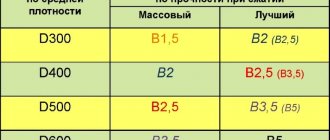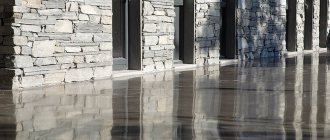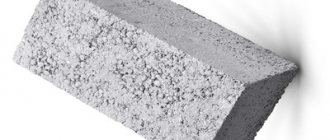Foam concrete is an artificial building material that is gaining increasing popularity in the construction industry. It is a porous material. The main components of foam concrete: cement, sand, foam and water. The density of foam concrete determines many of its characteristics, for example, thermal insulation and strength properties. Due to their low specific gravity and good workability, laying foam concrete blocks is relatively easy. Do you know what kind of concrete is needed for the foundation?
Area of application of foam concrete
Foam concrete has a wide range of applications, in particular:
- it is used to produce building blocks used for the construction of walls and partitions;
- it is used for monolithic housing construction;
- is a material for heat and sound insulation of walls, slabs, floors, ceilings;
- used as a filler for void spaces, hard-to-reach places, trench cavities;
- for thermal insulation of pipelines;
- They pour it on floors and roofs.
In terms of manufacturability, this material is superior to other structural materials. Foam blocks can be sawed, drilled, milled. In many characteristics they are close to similar parameters of wood, while differing in their durability for the better.
The material is several times superior in thermal insulation compared to brick. As a result, the thickness of the walls of buildings can be made thinner while maintaining the required parameters. In addition, given that the density of foam concrete (kg/cub.m) is lower, the total weight of the box can be significantly reduced when building a house. Thanks to this, it will be possible to reduce the load on the foundation, and it can be made lighter.
A useful article on how to correctly calculate a strip foundation.
Features of the material
Foam concrete products are produced for laying internal and external walls, as well as partitions, but the relative air humidity should not exceed 60 percent. In other conditions, the internal plane of the block is covered with a vapor barrier film.
This is how foam concrete blocks are laid.
The elements can be laid on a conventional cement mortar or on a layer of special glue. In the latter case, the thickness of the seam decreases, which has a positive effect on the thermal insulation characteristics of the building. That is, the occurrence of cold bridges is prevented.
What does the density value depend on?
This characteristic is mainly influenced by two parameters: the degree of porosity and the volume concentration of the filler. The role of the latter is played by sand, as well as fly ash. Fly ash is a finely dispersed material consisting of small particles. Sand is denser than ash, therefore, the greater its share in the solution, the higher the average density of foam concrete will be.
The presence of another component, a foaming agent, also plays an important role. Porosity directly depends on the amount of foaming agent in the mixture. Density, on the contrary, is inversely proportional. So, for example, to obtain concrete grade D400, you need to add 0.85 kg of this substance per 1 cubic meter of solution. Material with D1200 contains only 0.45 kg of foaming agent.
Universal monolith.
Monolithic foam concrete with a density of 200 - 400 kg/m3 (grades D200 - D400).
The lightest and warmest foam concrete is used for pouring flat roofs, first floor floors, wall wells, and pitched roof attics. This foam concrete can be used to fill house frames covered with plasterboard, glass-magnesium sheet, asbestos-cement sheet, etc. Frames can be made of plasterboard profiles, light metal profiles (LSTC), metal, wood, plywood, etc. The technology for constructing houses by monoliquing the frame is one of the most inexpensive in the construction industry. And despite the obvious cheapness, such housing will be non-flammable, will not be damaged by rodents and mold, will be warm and durable, and will not be blown by the wind.
Monolithic foam concrete with a density of 500 - 600 kg/m3 (grades D500 - D600)
Often used for leveling screeds on flat roofs. On top of a layer of such foam concrete, you can safely fuse a rolled bitumen roof or make a PVC membrane. Also used for installing leveling screeds followed by laying laminate and tiles. Load-bearing walls of cottages up to 2 floors high are poured from this foam concrete.
Monolithic foam concrete with a density of 700 - 800 kg/m3 (grades D200 - D400).
It is usually used for installing screeds followed by laying linoleum. Also, this foam concrete can be used to make load-bearing walls of low-rise buildings (up to 3 or 4 floors) with reinforced concrete floors.
| Rice. 6.7. The use of structural “heavy” monolithic foam concrete. Pouring foam concrete leveling screeds (instead of cement) with monolithic foam concrete with a density of D800. Working with foam concrete is much easier than with cement mortar - it is easier to feed, easier to lay and rub, foam concrete itself is lighter, warmer, and has higher sound insulation. The only drawback is less strength. |
| Rice. 8.9. The use of thermal insulation or “light” and structural-thermal insulation or “medium” monolithic foam concrete. Filling a flat roof with monolithic foam concrete for leveling and thermal insulation. The roof is made of two layers. The bottom layer is thermal insulating, made of foam concrete with a density of 250 kg/m3 - a thickness of 100 mm. The top layer of structural foam concrete with a density of 500 kg/m3 has a thickness of 30-40 mm. |
| Rice. 9.10. The use of heat-insulating “light” monolithic foam concrete. Pouring the wall of a private house with lightweight thermal insulating foam concrete with a density of d250. Pouring is done into a “well” with an internal wall made of silicate (white) brick and an external wall made of ceramic (red). Foam concrete is supplied to the work site through a hose; the worker’s task is only to hold the hose while pouring and prevent the foam concrete mixture from overflowing. |
If after reading this article you have any questions, we are always happy to answer them by email [email protected] or by phone.
[Back]
Relationship between various characteristics
The size of the pores (cells) is determined by the specific gravity of the concrete. In turn, all the main parameters of cellular concrete depend on their volume, volume distribution and nature. Porosity is inversely proportional to the value of this value (Table 1.)
Thermal conductivity is one of the most important characteristics of concrete. Reflects its ability to transmit thermal energy. Its value is determined directly by the density value. The combination of these parameters is the main factor on which the strength and warmth in the house depends. One of the undeniable qualities of foam concrete is low thermal conductivity (Table 2).
The strength of concrete is also directly proportional to the density value. As can be seen from Table 3, strength increases with increasing specific gravity of foam concrete. Foam blocks of various brands are used to perform different jobs. The classification of foam concrete by density is as follows. For grades D300 - D500, the strength is B0.5 - B1. Foam block with such characteristics is used as a thermal insulation material.
Grades D500 - D900 with strength B1 - B5 belong to structural and thermal insulation materials. Blocks of this class can be used to build one-story cottages. At D1000 - D1200, the corresponding strengths are B5 - B12.5. Such foam blocks are structural type blocks and can be used to build a multi-story building.
Thus, an increase in the specific gravity of foam concrete leads to an increase in its strength and thermal insulation properties. But if strength is not excessive, then the situation with thermal conductivity is not entirely clear. With a higher thermal conductivity coefficient, the material transmits heat faster. This means that it is less resistant to cold coming from outside. In other words, the house cools down faster, but the heat stays worse. From this article you will learn how to insulate a foundation.
It can be stated that density is the main quantitative characteristic of the structure of cellular concrete. As a consequence, it determines the meaning of all its technical properties. The tables given below very eloquently demonstrate the existence of a connection between such characteristics as porosity, strength, thermal conductivity and density of foam concrete.
Table 1
Porosity values
| Density, kg/cub.m | 400 | 500 | 600 | 700 | 800 | 900 | 1000 |
| Porosity, % | 80 | 78 | 73 | 70 | 67 | 63 | 60 |
table 2
Thermal conductivity values
| Density, kg/cub.m | 400 | 500 | 600 | 700 | 800 | 900 | 1000 |
| Thermal conductivity coefficient, W/(m°C) no more (on sand) | 0,10 | 0,12 | 0,14 | 0,18 | 0,21 | 0,24 | 0,29 |
Table 3
Strength class
| Density, kg/cub.m | 400 | 500 | 600 | 700 | 800 | 1000 | 1100 |
| Concrete class (max) compressive strength | B 0.75 | IN 1 | B 2.5 | V 3.5 | AT 5 | B 7.5 | AT 10 |
The main competitor of the foam concrete block is blocks made of autoclaved aerated concrete.
The white porous blocks that you might see on construction sites are autoclaved aerated concrete or gas silicate. Autoclaved aerated concrete is the main competitor of foam concrete. Externally, it is very similar to foam concrete. The main difference between autoclave materials is the composition of the raw materials. If foam concrete is made on the basis of cement, then autoclaved materials are made on the basis of lime. And since lime is white, aerated concrete blocks are also white. The beautiful white color is of course an interesting, but practically useless feature of aerated concrete. What is the difference between non-autoclaved foam concrete and autoclaved aerated concrete?
Cement non-autoclaved foam concrete hardens at any positive temperature, and lime aerated concrete only in an autoclave, at a pressure of 8 atmospheres and a temperature of 200 degrees. Cement foam concrete, unlike lime-based materials, is not afraid of water, and practically does not get wet in water. Lime aerated concrete from an autoclave quickly absorbs water, losing its strength and ability to store heat. If structural foam concrete floats in water indefinitely and does not get wet, then aerated concrete sinks after a few hours, having absorbed water. To sum it up briefly, let's say that aerated concrete is generally slightly stronger than foam concrete (as it hardens in an autoclave). At the same time, aerated concrete has significantly less durability than foam concrete. Foam concrete gains strength over time, while aerated concrete loses strength.
| Rice. 5. Foam concrete and gas silicate. Appearance. In the photo you see a fracture of a foam concrete block (on the left) and a gas silicate block (on the right). Foam concrete is gray in color and its pores are smaller than those of aerated concrete. The smaller the pores, the warmer the material. In addition, cement foam concrete is much more durable than lime aerated concrete. |
Choosing foam concrete
The question of the correct choice of material for construction deserves special attention. In relation to the foam block, as follows from the above, the main indicator is its specific gravity. How to determine the density of foam concrete? To do this, it is enough to divide the mass of the foam block by its volume. Foam concrete is marked with a number indicating the mass of 1 cubic meter of material.
The main advantages of this material include low density and low thermal conductivity. But the “warmer” it is, the lower its strength. Therefore, when buying this material, you need to find a compromise solution. You should search for the optimal option depending on the specific structure. This is one of the features of using this material. It is impossible to offer a single recommendation to all developers. The approach to choosing a class should be individual.
When building a house, it will be useful for you to know how to cut joints in concrete.
Product sizes
The most common foam block size, which is considered standard: 600x300x200 millimeters. It is these blocks that are used in the construction of load-bearing walls inside buildings. External walls are made of blocks measuring 600x400x200 millimeters.
Internal partitions are made from blocks with dimensions 600x300x100, subject to the impact of small loads on the structure. To increase the height of residential buildings on floors without the need to further strengthen the foundation, blocks measuring 600x250x100 millimeters are used.
Foam blocks with dimensions of 100x250x600 are often used in construction, which are relevant for the reconstruction of old buildings, laying out load-bearing and interior walls, creating interfloor ceilings, chambers for heat treatment, and freezing food. The standard size 600x250x75 is suitable for creating interior partitions.
If it is necessary to use foam blocks of other sizes in construction, the following options can be ordered at the factory: 600x300x250, 600x250x50, 600x250x200 and others.
Production technology
Foam blocks are made very simply. The process of their production is so accessible that you can even do it in a garage. You just need to stock up on foaming agent. All other components are the same available. A mixture of water, sand and cement must be kneaded in a clean container with the addition of a foaming ingredient. After this, the resulting composition is poured into molds. Foam blocks “reach” in natural conditions - they are left in the fresh air.
This process indicates that it is possible to produce such building materials without resorting to special equipment and tools.
Quality control in this case will be only conditional - it is important to adhere to the required proportions and technological processes. However, many manufacturers still strive to save money, so there are a lot of foam blocks on the market, the quality of which does not comply with GOST
Based on the production method, the following types of these materials for construction are distinguished:
- Cassette. During their production, foam concrete is poured into molds resembling cells. It is in them that further hardening of the material occurs. This usually takes about 10 hours.
- Passed automatic formwork. This cassette version of foam blocks is modernized. The molds for these materials are located in a special machine. After pouring the solution into them, hardening occurs after 14 hours. After this, the finished products are transferred to pallets.
- Sliced from solid wood. With this manufacturing method, a mixture of all the necessary ingredients is poured into a special large mold. Its volume can reach up to 3 cubic meters. m. In this form, the material hardens within 15 hours. After this, the resulting foam concrete slab is cut into separate blocks of the required sizes.
